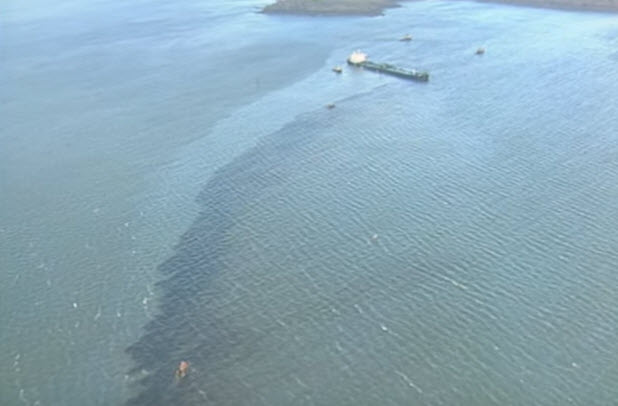20 Years Ago: The Sea Empress Grounding
The Liberian-registered tanker Sea Empress grounded on February 15, 1996, causing one of the U.K.’s largest oil spills.
The Sea Empress was en route to the Texaco oil refinery near Pembroke, Wales, when she grounded on mid-channel rocks at St. Ann's Head. Over the course of a week, she spilt 72,000 tons of crude oil into the sea.
The initial grounding resulted in a loss of 2,500 tons of crude oil. A further 69,300 tons of heavy fuel oil was lost during the salvage operation. The vessel was eventually refloated and taken into port on February 21.
.jpg) The spill occurred along the coast of the Pembrokeshire Coast National Park – one of Europe’s most important and sensitive wildlife and marine conservation areas. The area contains 35 Sites of Special Scientific Interest. Estimates suggest that 200 kilometers (124 miles) of coastline was affected by the spill.
The spill occurred along the coast of the Pembrokeshire Coast National Park – one of Europe’s most important and sensitive wildlife and marine conservation areas. The area contains 35 Sites of Special Scientific Interest. Estimates suggest that 200 kilometers (124 miles) of coastline was affected by the spill.
The initial cause of the accident was identified as pilot error and included miscalculation of the effects of the tidal stream. Secondary causes included poor weather and the use of tugs with insufficient pulling power.
Altogether the spill cost around £38 million ($55 million,) of which £28 million ($40 million) was spent on cleanup operations and the rest on compensation payments.
According to a WWF report, the consequences of the spills were mitigated due to:
• Time of year: the absence of tourists and the fact that many wildlife species were inactive or had migrated.
• Wind direction: as the wind was initially blowing from the north, 87 percent of oil was pushed away from the coast.
• Type of oil spilled and evaporation effect: Forties light is generally easier to disperse and treat chemically than some other oils.
• Success of chemical dispersants: the success of the early and continuous application of dispersants was in part due to the specific properties of the type of oil involved. It is estimated that 24 percent of the oil was dispersed in this manner and 28 percent by natural dispersal, i.e. wind and wave.
• A relatively small volume reaching the coastline: the quantity was estimated at between five and seven percent, i.e. a maximum of 5,300 tons. However, up to 16,000 tons of emulsified oil reached the coast.

The environmental impacts included the oiling of over 7,000 birds and a subsequent increase in algal growth which lead to high mortality amongst marine invertebrates.
The accident highlighted some important issues including the need for better tidal information and further training of pilots working in the area.
It also highlighted a lack of availability of emergency towing vessels. The power of the four attending tugs impacted greatly on the salvage operation having a combined bollard pull of only 174 tons which proved to be ineffective.
Changes to IMO legislation also followed to ensures that all tankers were required to have an emergency towing point (MSC.35 (63)).
Before the disaster there was proposal from BP to import Orimulsion from South America to Milford Haven and to burn it at Pembroke power station. Ormimulsion is a thick bitumen compound which has to be heated to keep it from solidifying.
There were fears voiced at the time about using single-hulled tankers like the Sea Empress to carry the fuel. It was seen as too much of a risk to carry it through such an environmentally important area as Orimulsion would sink rather that float on the surface like oil does. BP’s plans did not go ahead.
Following the disaster, the repaired Sea Empress changed hands several times and was renamed five times. She was set for scrapping in 2012, and while attempting to dock in Chittagong, Bangladesh, she was ruptured again after she hit a sunken vessel.
The opinions expressed herein are the author's and not necessarily those of The Maritime Executive.
